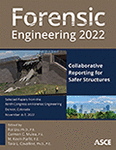The Need for Fire Safety Performance-Based Design in an Increasingly Prescriptive Environment
Publication: Forensic Engineering 2022
ABSTRACT
Numerous life-loss events over the past two decades have reinforced the need to critically examine how the architectural and engineering community approaches fire and life safety for innovative new and complex existing buildings alike. Recent incidents demonstrate that standardized approaches to performance-based analysis need to be implemented by designers, and that a system to vet those designs should more readily be accommodated by public agencies responsible for review. While advances in structural analysis and building modeling have facilitated the design of structures that expand the imagination, the approach to fire and life safety has not evolved at the same pace. This paper examines the relationship between failure analysis and the use of Performance-Based Design in the built environment. The role of post-incident analyses in discovering previously unknown behaviors and the translation of scientifically based analysis into a workable design framework is addressed. Additionally, the contribution of empirical data and the importance of establishing standards of practice that inform how professional engineers should approach their designs is explored in the context of a healthy Performance-Based Design ecosystem.
Get full access to this article
View all available purchase options and get full access to this chapter.
REFERENCES
ASCE. (2018). Manuals and Reports on Engineering Practice No. 138: Structural Fire Engineering, K.J. LaMalva, ed., ASCE, Reston, VA.
ASCE. (2020). Performance-Based Structural Fire Design – Exemplar Designs of Four Regionally Diverse Buildings using ASCE 7-16 Appendix E, ASCE, Reston VA.
Best, R., and Demers, D. P. (1982). “Report on the MGM Grand Hotel Fire-Las Vegas 21, 1980.” National Fire Protection Association Fire Journal, Quincy, MA.
Cox, G. (1992). Some Recent Progress in the Field Modelling of Fire, Fire Research Station, Borehamwood, Hertfordshire, UK, Building Research Establishment.
Edgar, R. A., Sharples, J. J., and Sidhu, H. S. (2015). “Revisiting the King’s Cross Underground disaster with implications for modelling wildfire eruption,” 21st International Congress on Modelling and Simulation, Gold Coast, Australia, 29 Nov to 4 Dec.
Federal Building and Fire Safety Investigation of the World Trade Center Disaster. (2005). Final Report on the Collapse of the World Trade Center Towers, US Government Printing Office, Washington, DC.
Fennell, D. (1988). Investigation into the King’s Cross Underground Fire, published for the Department of Transport for Her Majesty’s Stationery Office.
Grosshandler, W. L., et al. (2005). Report of the Technical Investigation of The Station Nightclub Fire, US Department of Commerce, National Institute of Standards and Technology.
Guinn, K. G. (1981). The Report of the Governor’s Commission on Firesafety Codes, Nevada Independent Insurance Agents.
Lovatt, A., and Fleischmann, C. (1988). Comparison Studies of Zone and CFD Fire Simulations,.
Meacham, B. J., and Thomas, J. R. (2013). “NRCC, 20 Years of Performance-Based Fire Protection Design: Challenges Faced and a Look Ahead,” Journal of Fire Protection Engineering, No. 4, January, 249–276.
Moodie, K. (1992). “The King’s Cross fire: damage assessment and overview of the technical investigation,” Fire Safety Journal, 18(1), 13–33.
NFPA (National Fire Protection Association). (2017). Guide for Fire and Explosion Investigations, NFPA, Quincy, MA, 2017.
NIST. (2013). Fire Dynamics Simulator, Technical Reference Guide, Sixth Edition, November 4, Gaithersburg, Maryland.
SFPE (Society of Fire Protection Engineers). (2015). The SFPE Guide to Performance-Based Fire Safety Design, SFPE, Gaithersburg, MD.
Simcox, S., Wilkes, N. S., and Jones, I. P. (1992). “Computer Simulation of the Flows of Hot Gases from the Fire at King’s Cross Underground Station,” Fire Safety Journal, 18, 49–73.
Teague, P. E., and Farr, R. R. (2009). “Case Histories: Fires Influencing the Life Safety Code,” The 2009 Life Safety Code Handbook, National Fire Protection Association.
CROSS (The Institution of Structural Engineers Confidential Reporting on Structural Safety). https://www.istructe.org/resources/blog/cross-5-key-elements-structural-safety-reporting/.
Toplikar, D. (2012). “MGM Grand, Hilton Fires Led to Improved Safety Codes,”, 21 November.
Information & Authors
Information
Published In
History
Published online: Nov 2, 2022
Authors
Metrics & Citations
Metrics
Citations
Download citation
If you have the appropriate software installed, you can download article citation data to the citation manager of your choice. Simply select your manager software from the list below and click Download.
